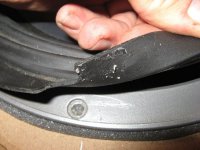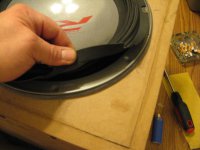I picked up a Alpine Type-R 12" 2ohm DVC model SWR-1222D off of Craigslist for 60 bucks. Built a new box for it ( My First attempt at ever building a box). I get the box all done, mount the sub-woofer and am hearing air leaking out around the screw holes. Upon closer inspection I realize that the surround is separating from the basket. I started doing some research and here is what I learned. Most manufactures use CA glue to attach surrounds to the basket, and apparently Alpines glue is terrible. I was worried CA glue was going to cost me a fortune. Turns out it is just the chemical name for Super-Glue, go figure. So here we go.

My surround was separated in quite a few places and the glue seemed really soft and rubbery. So I peeled the entire surround off the basket. I wouldn't recommend this unless it comes apart really easy. Just reattach the separated areas.
Also make sure you get all the old glue off the basket and surround as well as any dust. I used rubbing alcohol and it worked very well.

Clean surround and basket.
I don't have pictures of the actual super gluing the surround back on because of how fast the stuff dries. Just put enough glue down so when you press the surround into it it completely covers the contact point and in a matter of seconds that section of surround is reattached. I also suggest working on 1/8th of the surround at a time or if your speaker only has 6 holes 1/6 at a time. so you don't end up with glue drying before you can put the surround in the correct place.

Completely Repaired and the total time spent on the job was maybe 15-20 minutes including running to Walgreens at 11pm to buy superglue.

My surround was separated in quite a few places and the glue seemed really soft and rubbery. So I peeled the entire surround off the basket. I wouldn't recommend this unless it comes apart really easy. Just reattach the separated areas.
Also make sure you get all the old glue off the basket and surround as well as any dust. I used rubbing alcohol and it worked very well.

Clean surround and basket.
I don't have pictures of the actual super gluing the surround back on because of how fast the stuff dries. Just put enough glue down so when you press the surround into it it completely covers the contact point and in a matter of seconds that section of surround is reattached. I also suggest working on 1/8th of the surround at a time or if your speaker only has 6 holes 1/6 at a time. so you don't end up with glue drying before you can put the surround in the correct place.

Completely Repaired and the total time spent on the job was maybe 15-20 minutes including running to Walgreens at 11pm to buy superglue.

